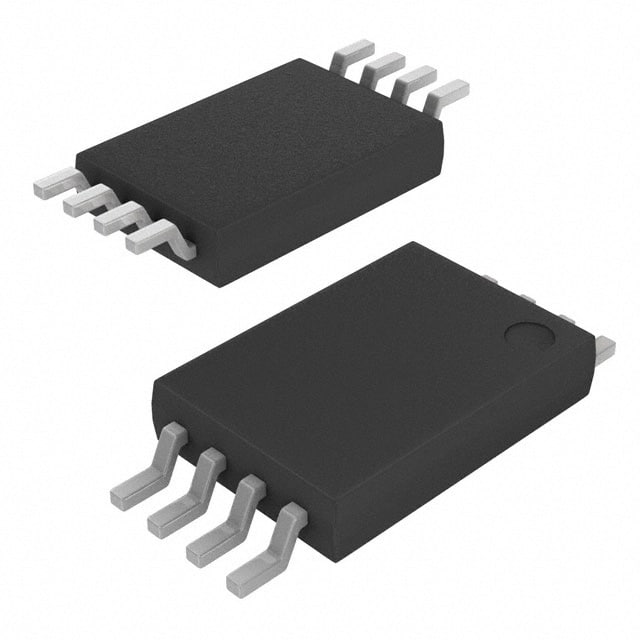LM311PW
Product Overview
Category: Integrated Circuit (IC)
Use: The LM311PW is a high-speed voltage comparator designed for use in various electronic applications. It compares two input voltages and provides an output based on the comparison result.
Characteristics: - High speed: The LM311PW operates at a high speed, making it suitable for time-critical applications. - Wide input voltage range: It can handle a wide range of input voltages, allowing flexibility in different circuit designs. - Low power consumption: The LM311PW consumes low power, making it energy-efficient. - Output compatibility: It provides compatible outputs that can be easily interfaced with other digital or analog circuits.
Package: The LM311PW is available in a small outline package (SOP) with 8 pins.
Essence: The LM311PW is an essential component in electronic circuits where voltage comparison is required.
Packaging/Quantity: The LM311PW is typically sold in reels containing a specific quantity of ICs, such as 2500 units per reel.
Specifications
- Supply Voltage Range: 2V to 36V
- Input Offset Voltage: 2mV (maximum)
- Input Bias Current: 150nA (maximum)
- Response Time: 165ns (typical)
- Operating Temperature Range: -40°C to +85°C
Pin Configuration
The LM311PW has 8 pins arranged as follows:
___________
VCC |1 8| GND
IN- |2 7| OUT
IN+ |3 6| NC
NC |4 5| NC
‾‾‾‾‾‾‾‾‾‾‾‾
Functional Features
- Voltage comparison: The LM311PW compares the voltages applied to its input pins and produces a corresponding output based on the comparison result.
- Open collector output: It provides an open collector output, allowing easy interfacing with other circuits.
- Adjustable hysteresis: The LM311PW allows the user to adjust the hysteresis level, providing flexibility in different applications.
- Built-in voltage reference: It includes a built-in voltage reference for accurate voltage comparison.
Advantages and Disadvantages
Advantages: - High-speed operation enables time-critical applications. - Wide input voltage range allows flexibility in circuit design. - Low power consumption for energy efficiency. - Compatible outputs simplify interfacing with other circuits.
Disadvantages: - Limited number of pins may restrict complex circuit designs. - Requires external components for certain applications. - Sensitivity to noise and interference may affect performance in some environments.
Working Principles
The LM311PW works by comparing the voltages applied to its input pins (IN+ and IN-) and producing an output based on the comparison result. When the voltage at the IN+ pin is higher than the voltage at the IN- pin, the output goes low. Conversely, when the voltage at the IN- pin is higher, the output goes high. This behavior allows the LM311PW to function as a voltage comparator.
Detailed Application Field Plans
The LM311PW finds applications in various fields, including:
- Industrial automation: It can be used in control systems to compare sensor voltages and trigger appropriate actions.
- Power electronics: The LM311PW can be employed in power supply circuits to monitor voltage levels and provide feedback for regulation.
- Communication systems: It can be utilized in signal processing circuits to compare analog signals and make decisions based on the comparison results.
- Automotive electronics: The LM311PW can be integrated into automotive systems for voltage monitoring and fault detection.
Detailed and Complete Alternative Models
- LM339: This quad voltage comparator offers similar functionality to the LM311PW but with four independent comparators in a single package.
- LM393: Another dual voltage comparator that provides comparable performance to the LM311PW, suitable for applications requiring two comparators.
- LM324: A quad operational amplifier that can be used as a voltage comparator, offering additional amplification capabilities.
These alternative models provide options based on specific application requirements and desired features.
Word count: 537 words
Lista 10 Vanliga frågor och svar relaterade till tillämpningen av LM311PW i tekniska lösningar
Sure! Here are 10 common questions and answers related to the application of LM311PW in technical solutions:
Q: What is LM311PW? A: LM311PW is a high-speed voltage comparator integrated circuit (IC) commonly used in various technical applications.
Q: What is the operating voltage range of LM311PW? A: The operating voltage range of LM311PW is typically between 5V and 30V.
Q: Can LM311PW be used as a voltage level detector? A: Yes, LM311PW can be used as a voltage level detector due to its high-speed response and open collector output.
Q: How does LM311PW handle input signals? A: LM311PW compares the voltage levels of two input signals and provides a corresponding output based on their relationship.
Q: Can LM311PW operate with both single-ended and differential inputs? A: Yes, LM311PW can operate with both single-ended and differential inputs, making it versatile for different applications.
Q: What is the maximum output current capability of LM311PW? A: The maximum output current capability of LM311PW is typically around 50mA.
Q: Is LM311PW suitable for high-frequency applications? A: Yes, LM311PW is suitable for high-frequency applications due to its fast response time and wide bandwidth.
Q: Can LM311PW be used as a pulse width modulator (PWM)? A: While LM311PW is primarily a voltage comparator, it can be used in conjunction with other components to create a PWM circuit.
Q: Does LM311PW have built-in hysteresis? A: No, LM311PW does not have built-in hysteresis. However, external components can be added to introduce hysteresis if needed.
Q: What are some common applications of LM311PW? A: LM311PW is commonly used in applications such as motor control, waveform generation, voltage monitoring, and analog-to-digital converters (ADCs).
Please note that the answers provided here are general and may vary depending on specific circuit designs and requirements.


